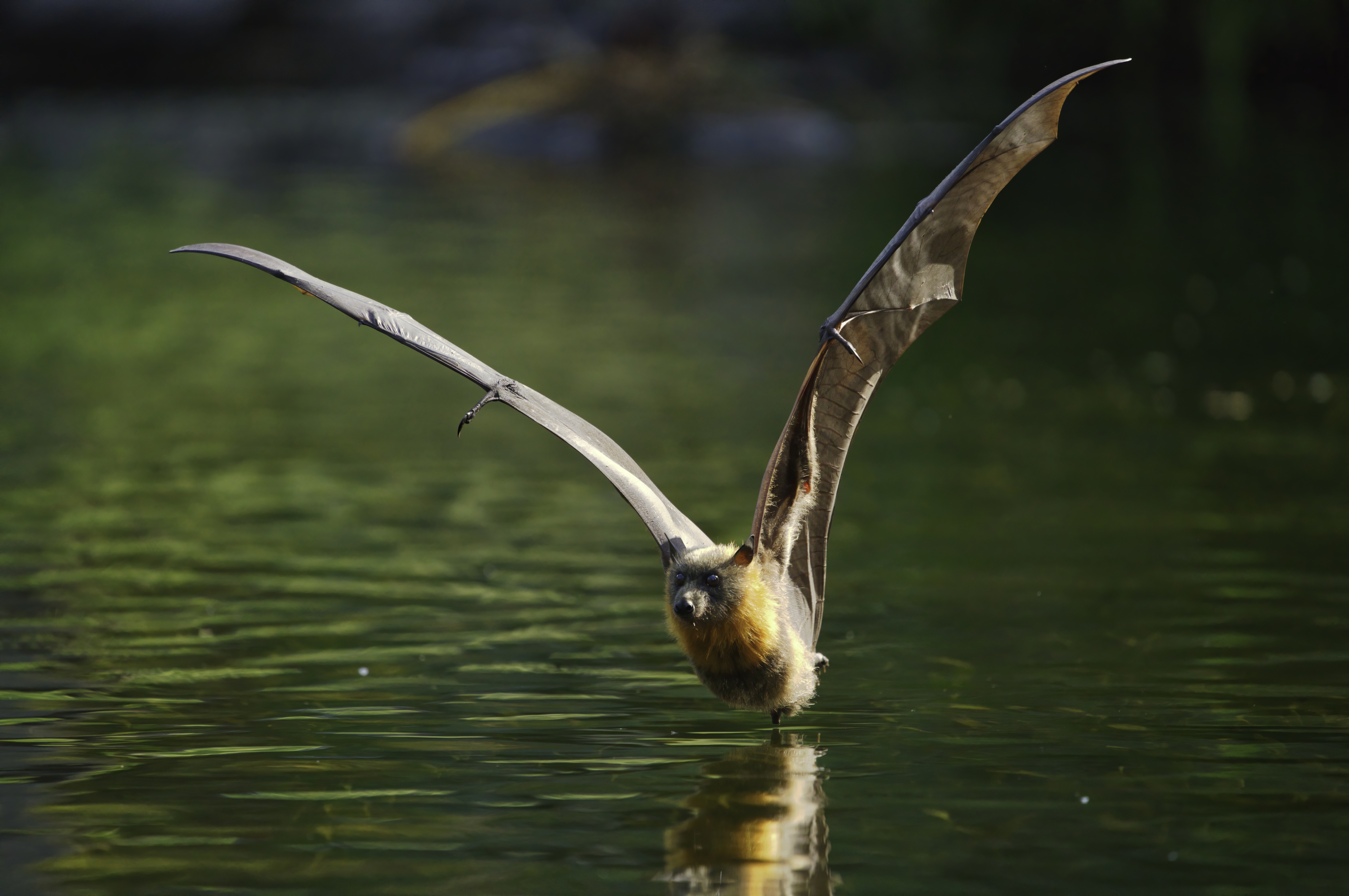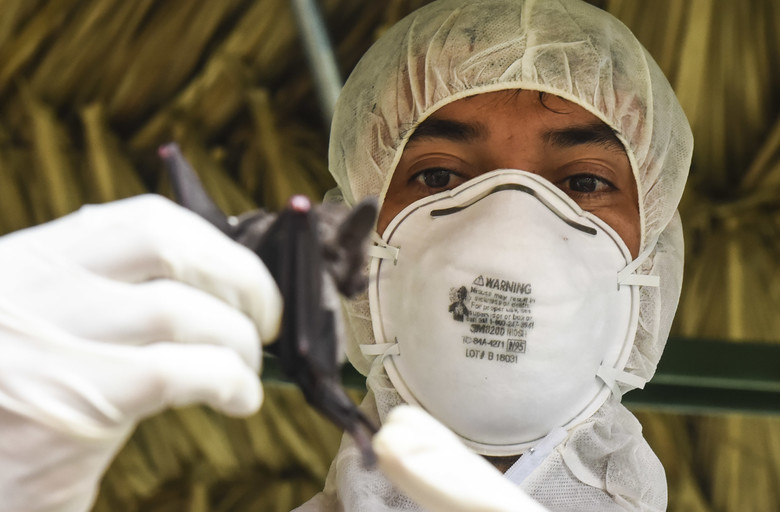|
Nelson Bay Orthoreovirus
''Nelson Bay orthoreovirus'', often called Nelson Bay virus (NBV) is a novel double-stranded RNA orthoreovirus species first isolated from a flying fox (Pteropus poliocephalus) near Nelson Bay in New South Wales, Australia.Gard G, Compans RW. Structure and cytopathic effects of Nelson Bay virus. J Virol. 1970 Jul;6(1):100–6. Virology Genome The NBV has a morphology similar to other orthoreoviruses, but has a much more rapid cytopathic effect. See also * Bat virome * Double-stranded RNA viruses * Oncolytic virus * Orphan virus * Xi River virus Xi River virus (XRV) is a putative novel bat virus in the genus ''Orthoreovirus'' isolated from fruit bats in Guangdong Province in southern China. It is the first bat reovirus isolated in China. Virology Genome Only a partial sequence of XR ... References External links MicrobiologyBytes€”Reoviruses {{Taxonbar, from=Q15674491 Orthoreoviruses Bat virome ... [...More Info...] [...Related Items...] OR: [Wikipedia] [Google] [Baidu] |
Grey-headed Flying Fox
The grey-headed flying fox (''Pteropus poliocephalus'') is a megabat native to Australia. The species shares mainland Australia with three other members of the genus ''Pteropus'': the little red ''Pteropus scapulatus, P. scapulatus'', spectacled ''Pteropus conspicillatus, P. conspicillatus'', and the black ''Pteropus alecto, P. alecto''. The grey-headed flying fox is the largest bat in Australia. The grey-headed flying fox is endemic to the south-eastern forested areas of Australia, principally east of the Great Dividing Range. Its range extends approximately from Bundaberg, Queensland, Bundaberg in Queensland to Geelong, Victoria, Geelong in Victoria (Australia), Victoria, with outlying colonies in Ingham, Queensland, Ingham and Finch Hatton, Queensland, Finch Hatton in the north, and in Adelaide, South Australia, Adelaide in the south. In the southern parts of its range it occupies more extreme latitudes than any other ''Pteropus'' species. As of 2021 the species is listed as ... [...More Info...] [...Related Items...] OR: [Wikipedia] [Google] [Baidu] |
Nelson Bay, New South Wales
Nelson Bay is a significant township of the Port Stephens local government area in the Hunter Region of New South Wales, Australia. It is located on a bay of the same name on the southern shore of Port Stephens about by road north-east of Newcastle, its nearest rail link. At th2021 census Nelson Bay had a population of 6,141. It is a major tourism centre, particularly for dolphin and whale watching, surfing, diving, fishing and other recreational aquatic activities. The eastern boundaries of Nelson Bay lie within the Tomaree National Park while the southeastern section is almost entirely within the park. Nelson Head Light, an unusual lighthouse built in 1875, is positioned on the northeast corner. Early settlers Early settlers included the Dalton family, the patriarch being Captain John Dalton who sailed his ship SS ''Kingsley'' to Sydney with fresh marine produce from Port Stephens. He built a house "Westward Ho" in 1882 on the hill overlooking the modern town, on . He don ... [...More Info...] [...Related Items...] OR: [Wikipedia] [Google] [Baidu] |
Cytopathic Effect
Cytopathic effect or cytopathogenic effect (abbreviated CPE) refers to structural changes in host cells that are caused by viral invasion. The infecting virus causes lysis of the host cell or when the cell dies without lysis due to an inability to replicate. Both of these effects occur due to CPEs. If a virus causes these morphological changes in the host cell, it is said to be cytopathogenic. Common examples of CPE include rounding of the infected cell, fusion with adjacent cells to form syncytia, and the appearance of nuclear or cytoplasmic inclusion bodies. CPEs and other changes in cell morphology are only a few of the many effects by cytocidal viruses. When a cytocidal virus infects a permissive cell, the viruses kill the host cell through changes in cell morphology, in cell physiology, and the biosynthetic events that follow. These changes are necessary for efficient virus replication but at the expense of the host cell. Diagnostics CPEs are important aspects of a viral infec ... [...More Info...] [...Related Items...] OR: [Wikipedia] [Google] [Baidu] |
Bat Virome
The bat virome is the group of viruses associated with bats. Bats host a diverse array of viruses, including all seven types described by the Baltimore classification system: (I) double-stranded DNA viruses; (II) single-stranded DNA viruses; (III) double-stranded RNA viruses; (IV) positive-sense single-stranded RNA viruses; (V) negative-sense single-stranded RNA viruses; (VI) positive-sense single-stranded RNA viruses that replicate through a DNA intermediate; and (VII) double-stranded DNA viruses that replicate through a single-stranded RNA intermediate. The greatest share of bat-associated viruses identified as of 2020 are of type IV, in the family ''Coronaviridae''. Bats harbor several viruses that are zoonotic, or capable of infecting humans, and some bat-borne viruses are considered important emerging viruses. These zoonotic viruses include the rabies virus, SARS-CoV, MERS-CoV, Marburg virus, Nipah virus, and Hendra virus. While research clearly indicates that SARS-Co ... [...More Info...] [...Related Items...] OR: [Wikipedia] [Google] [Baidu] |
Double-stranded RNA Viruses
Double-stranded RNA viruses (dsRNA viruses) are a polyphyletic group of viruses that have double-stranded genomes made of ribonucleic acid. The double-stranded genome is used to transcribe a positive-strand RNA by the viral RNA-dependent RNA polymerase (RdRp). The positive-strand RNA may be used as messenger RNA (mRNA) which can be translated into viral proteins by the host cell's ribosomes. The positive-strand RNA can also be replicated by the RdRp to create a new double-stranded viral genome. Double-stranded RNA viruses are classified in two separate phyla ''Duplornaviricota'' and ''Pisuviricota'' (specifically class ''Duplopiviricetes''), which are in the kingdom ''Orthornavirae'' and realm ''Riboviria''. The two groups do not share a common dsRNA virus ancestor. Double-stranded RNA viruses evolved two separate times from positive-strand RNA viruses. In the Baltimore classification system, dsRNA viruses belong to Group III. Virus group members vary widely in host range (anim ... [...More Info...] [...Related Items...] OR: [Wikipedia] [Google] [Baidu] |
Oncolytic Virus
An oncolytic virus is a virus that preferentially infects and kills cancer cells. As the infected cancer cells are destroyed by lysis#Oncolysis, oncolysis, they release new infectious virus particles or virus, virions to help destroy the remaining tumour. Oncolytic viruses are thought not only to cause direct destruction of the tumour cells, but also to stimulate host anti-tumour innate immune system, immune system responses. Oncolytic viruses also have the ability to affect the tumor micro-environment in multiples ways. The potential of viruses as anti-cancer agents was first realised in the early twentieth century, although coordinated research efforts did not begin until the 1960s. A number of viruses including adenoviridae, adenovirus, reoviridae, reovirus, measles virus, measles, herpes simplex virus, herpes simplex, Newcastle disease, Newcastle disease virus, and vaccinia have been clinically tested as oncolytic agents. Most current oncolytic viruses are engineered for tumou ... [...More Info...] [...Related Items...] OR: [Wikipedia] [Google] [Baidu] |
Orphan Virus
An orphan virus is a virus that is not associated with a disease but may possess pathogenicity. Some orphan viruses include adeno-associated virus (Parvoviridae), human herpesvirus 7 (Herpesviridae), human foamy virus (Retroviridae), Human Reovirus (Reoviridae), hepatitis G (Flaviviridae), and TT virus (Anelloviridae). Gilbert Dalldorf, a pathologist who showed that Coxsackie viruses paralyze mice but not humans, indicated that the term ‘orphan’ was created "in a moment of conviviality" by a group of virologists.Mortimer, Philip P. "Orphan Viruses, Orphan Diseases: Still the Raw Material for Virus Discovery." Reviews in Medical Virology 23.6 (2013): 337-39. Web. Many enteroviruses are referred to as ECHO, enteric cytopathic human orphan viruses, because they were originally not associated with any disease. Even though many of them are associated with severe diseases, the name ECHO still continues to be used. See also *Novel virus *Reoviridae *Viral metagenomics Viral me ... [...More Info...] [...Related Items...] OR: [Wikipedia] [Google] [Baidu] |
Xi River Virus
Xi River virus (XRV) is a putative novel bat virus in the genus ''Orthoreovirus'' isolated from fruit bats in Guangdong Province in southern China. It is the first bat reovirus isolated in China. Virology Genome Only a partial sequence of XRV was isolated from the fruit bat, but based on its open reading frame it was identified as a reovirus. XRV has the same morphology and high sequence identity as Nelson Bay virus (NBV), and a 10-segmented double-stranded RNA genome, as well as high sequence identity to NBV members.MicrobiologyBytes – Reoviruses Reoviruses are non-enveloped, double-stranded RNA viruses. They have an |


